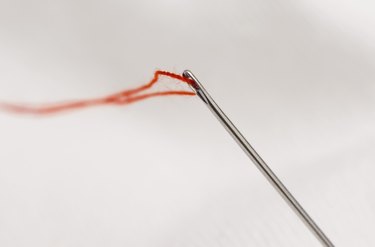Things You'll Need
Blind shim or chip
String
Scissors
Sewing needle
Blind bracket

Cellular shades come in a wide variety of colors and fabrics. But after much use, these pleated blinds can begin to wear out; strings may break and the blinds may not roll up or down as fast as they once did. Whatever the problem, it may be more economical to fix the shades yourself rather than purchasing a separate unit. It just takes a few basic materials and a little effort to repair your cellular shades.
Step 1
Repair sagging at the bottom of the cellular shade by replacing the shim or clip in the head rail. Extend the blinds all the way and take them down from the window. Slide the shim in the grooves beneath the metal bar in the underside of the head rail. It should snap into place and most likely will fix the problem.
Video of the Day
Step 2
If the blinds will not hang evenly, look inside the head rail and see if the cord is caught in it. Pull the cord if it is stuck and lift and lower the blinds with the pull cord, which should fix the problem.
Step 3
Pull the bottom and head rails off the end of the fabric away from the cord lock to restring a cellular shade. Pile the fabric on top of each other. Remove the plastic washer and cord from the fabric. Toss out the string, but keep the other parts, because you will need them for later.
Step 4
Trim the string with scissors and each cord should be twice as long as the shade plus the width. Thread the string through the opening of a needle and shove the needle through the space in the cord lock and then through the holes in the stack of fabric. Push the needle through the cord lock hole in the bottom rail.
Step 5
Set plastic washer on the end of each cord and tie a double knot in the string. Place this on the bottom of the shade and the filler strip on the bottom. Replace the head rail on the filler strip and shove the cords under it. Hook the shade back on the wall.
Step 6
Release tension in a cellular shade when it is wound too tight and flies up rapidly or is difficult to pull down. Let the shade roll up to the top and unhook it from the brackets. Partially unroll the shade by hand and set it back in the brackets, while it is still half way unrolled. Check to see if it fixed the problem and repeat the steps if it is still too tight.
Step 7
Fix a cellular shade that does not roll up easily by moving one of the brackets a little farther away from the other. You can also gently bend one of the brackets to allow more space between the two to free up the blinds.
Step 8
Help a shade to stop when there is improper tension on the spring. Inspect the bracket that holds the flat pin in the end of the head rail and see if it is worn out or bent, which could allow the pin to move out of place. Replace the bracket if it is worn out.
Tip
Consult the manufacturer to make sure you have the correct size string for the type of blinds that you have, since there are varying sizes.
If the blinds are not rolling up easily and have inside brackets, take the shade down and lightly tap each bracket with a hammer to flatten them a little to create more space between them. If this still does not work, the roller will have to be shortened. Use pliers to pull out the round pin and the cap from the end of the roll and cut the proper amount of roller off with a hand saw. Replace the pin and cap by lightly pounding in place with a hammer.
Video of the Day